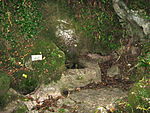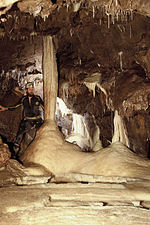Cook's Wood Quarry
Cook's Wood Quarry also known as Holcombe Quarry (grid reference ST669479) is a 0.8-hectare (2.0-acre) geological Site of Special Scientific Interest near Stoke St Michael on the Mendip Hills in Somerset, notified in 1988. This is a Geological Conservation Review Site. This site partially overlaps with St. Dunstan's Well Catchment SSSI. The main exposures are cut in very steeply-dipping Carboniferous Limestone. This was the original locality for the type section of the proposed ‘Cookswoodian Stage’. 9 species of Bat, Dormice and four species of Newts including the rare Great Crested Newt reside in Cooks Wood Quarry.Planning permission for the disused quarry has been granted to turn it into a holiday retreat.
Excerpt from the Wikipedia article Cook's Wood Quarry (License: CC BY-SA 3.0, Authors).Cook's Wood Quarry
Bector Lane, Mendip Stoke St Michael
Geographical coordinates (GPS) Address Nearby Places Show on map
Geographical coordinates (GPS)
| Latitude | Longitude |
|---|---|
| N 51.22932 ° | E -2.47542 ° |
Address
Bector Lane
Bector Lane
BA3 5WP Mendip, Stoke St Michael
England, United Kingdom
Open on Google Maps








